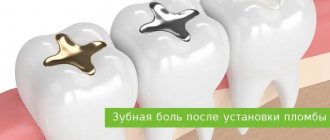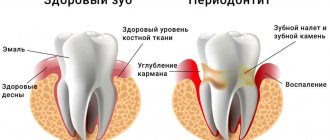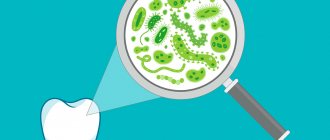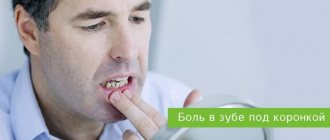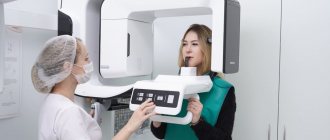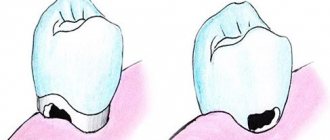The vast majority of the adult population of the planet is familiar with toothache. It can manifest itself in different ways, including when pressure is applied to a tooth, when a person cannot bite even soft food.
| Causes of pain and accompanying conditions | Methods for eliminating toothache |
| Increased sensitivity of the tooth in the absence of external damage, pain occurs even with slight pressure | At home: rinsing with herbal decoctions, soda solution When visiting a doctor: remineralization (treatment with preparations containing calcium and fluoride), in some cases - building up new enamel |
| Damage to enamel (cracks, chips - including microscopic ones invisible to the eye), the appearance of severe pain when exposed to any factor | It is recommended to consult a doctor |
| Inflammation of the gums: pain occurs when pressing on a healthy tooth precisely because of the condition of the gums | At home: rinse with a water-soda solution, sea buckthorn oil lotions. If there is no effect, you should consult a doctor. |
| Inflammation of the upper part of the tooth (periodontitis), accompanied by independent, precisely localized pain and a general deterioration of the condition | Treatment at home is impossible; you need to see a doctor. During the first week after removal: rinse |
| Removal of the nerve: after depulpation, pain may persist due to injury to the fibers (the reason is unskilled intervention that led to tissue necrosis due to insufficient asepsis of the canals) | The persistence (especially the intensification) of pain requires immediate contact with a doctor in case of a medical error |
| A complication of caries is pulpitis, intense pain that intensifies when chewing, discoloration of tooth enamel (graying) | requires immediate medical attention; if delayed, tooth loss may occur |
Pain when pressing on a tooth after treatment
Pain when pressing on a treated tooth is an absolute norm: any dental intervention has a traumatic effect on the gum tissue, recovery takes some time, but every day the pain weakens.
In patients with increased tooth sensitivity or a low pain threshold, the recovery process may take 1-2 months.
To alleviate the condition during this period, it is recommended:
- Thorough brushing of teeth using dental floss;
- rinsing (starting from the fourth day after treatment);
- use of painkillers.
Why complications arise
Deformation of tissues (even minimal chips of enamel) causes various complications, which is associated with the penetration of infections into the depths of the tooth. Among the most serious complications:
- abscess (can spread to several teeth or cover half the jaw);
- sinusitis, pharyngitis, sepsis;
- inflammation of the jaw bone;
- development of phlegmon (with damage to the facial muscles).
All these infections are fraught with penetration into the blood and disruption of the general condition of the body.
The most common complication is the development of caries, which, in the absence of adequate treatment, leads to complete destruction of the tooth with the need for its removal.
Reasons not related to teeth
With severe toothache, it seems that everything hurts - the ear, throat, head and even the skin on the face. In some cases, a person is not able to determine the source of the sensation and believes that a bad tooth is to blame.
Night pain similar to toothache can also occur in the following cases:
- For inflammation of the trigeminal nerve. Characterized by a nagging, severe pain, localized in the area of one tooth or spread throughout the entire jaw. This is explained by the fact that the branches of the nerve are located very close to the roots of the teeth and when they become inflamed, pain occurs that is very similar to toothache.
- For sinusitis, sinusitis, otitis media. Swollen tissues and sinuses filled with purulent contents put pressure on the roots of the teeth. The resulting pain is very similar to toothache. In most cases, it is observed in children who find it difficult to correctly determine the location of pain
- Under stress. Chronic night pain can be considered as one of the factors confirming the stressful state of the body.
Important.
Even if you have such assumptions, you will still have to visit the dentist. This must be done in order to exclude inflammatory diseases of the teeth and oral cavity, correctly diagnose and prescribe the correct treatment.
How to cope with pain?
Toothache is always a good reason to see a doctor; it’s worth taking the time to avoid complications!
If professional dental care is not possible, first aid is to relieve pain and minimize inflammation.
Analgesics of various effects used in dentistry - tempalgin, ketorol, nurofen; standard dosage regimen - 1-2 tablets every 4 hours; The effect of the drugs begins within the first 15 minutes and lasts up to 6 hours.
Rinse for painful sensations
Rinses are also widely used - both homemade and pharmacy. For example:
- 100 ml of water, a teaspoon of soda, a teaspoon of soda, iodine - 5 drops. Used to relieve swelling and remove purulent contents
- 1 spoon of sage per glass of boiling water (decoction), anise - 10 drops. Provides pain relief and has an anti-inflammatory effect.
- 1 glass of warm water, 1 tablet of furacillin. Powerful antibacterial effect, reducing swelling.
The drug chlorhexidine has a good aseptic effect; so-called dental elixirs can be used to relieve pain.
It is important to understand that all the methods listed above are only first aid for toothache; if you stop there, you will soon inevitably need tooth extraction!
To eliminate pain, it is necessary to identify and eliminate the cause of the problem. This can only be done in a dental clinic, where modern equipment ensures comfortable and painless treatment.
Diseases that provoke painful pulsation in the tooth
Suddenly got a toothache? At the appointment, the dentist usually diagnoses one of the following diseases.
Caries
First, with carious tooth decay, throbbing pain periodically occurs after eating hot/cold food, eating sweets or sour fruits. This means that the pathological process has reached the dentin (the tissue located under the tooth enamel). As the carious cavity deepens, the intensity of the pain increases, but after 10-15 minutes everything goes away without taking painkillers. If you do not consult a dentist in time, the dental crown will be completely destroyed very quickly. However, at this stage it is possible to save not only the tooth, but also avoid removing the nerve.
Important! Sometimes only a small hole is noticeable in the tooth enamel. However, the carious process spreads inside the tooth. A sign of deep caries (in addition to pain) is bad breath.
For caries, it is not recommended to put analgin into the tooth. This drug, although it effectively relieves pain, instantly destroys tooth enamel. It is impossible to save a tooth that is more than 2/3 destroyed.
Pulpitis
Inflammation of the pulp (neurovascular bundle) is a complication of deep caries. During the day, throbbing pain is quite tolerable, it occurs only after eating or inhaling cold air, and is easily relieved with painkillers. By nightfall the tooth begins to twitch.
The worst tactic for pulpitis is to drown out the pain with strong analgesics and again postpone going to the dentist in the morning. It makes no sense to endure pain day after day; in any case, the nerve will have to be removed. However, when the pulp is removed, the tooth stops receiving nutrition, the enamel and dentin become less dense.
Even a filled tooth with the nerve removed is short-lived. Therefore, we recommend that you contact the Matiss Dent dental clinic as soon as painful sensitivity to hot/cold occurs or a small dark spot appears on the enamel.
Periodontitis
If the infection penetrates deeper, a fibrous compaction or granuloma forms at the apex of the root. In this case, the pulsation is usually painless and intensifies when chewing food. The patient feels as if the tooth has lengthened.
With the development of a purulent process, a periapical abscess (cyst) is formed. The throbbing pain in the tooth increases (it jerks more and more), the gums swell, and painkillers only slightly ease the pain. Possible increase in temperature. Sometimes after a few days the abscess forms a white “bump” on the gum.
Important! Under no circumstances should you open a root cyst yourself. Any manipulations at home are fraught with the development of perimandibular abscess and sepsis.
Previously, the cyst was removed along with the tooth. However, modern dentistry makes it possible to preserve the root. The abscess is opened through the root canal (the capsule is scraped out with a curette or dissolved with special substances) or removed surgically in combination with antibiotics. The resulting cavity is filled with a paste that restores bone tissue. The tooth is built up using pins, then a crown is installed. An indicator of successful removal of a periapical abscess is that an x-ray taken 6 months later shows no evidence of new cyst formation.
Periodontitis
Inflammation of the periodontium (supporting apparatus of the teeth) is the most insidious dental disease. At the initial stage, the pathology is manifested only by increased bleeding of the gums after brushing teeth, eating carrots and other solid foods.
Over time, degenerative changes occur in the gums: the spaces between the crowns increase, the roots of the teeth become exposed, and a metallic taste is constantly felt in the mouth due to increased bleeding. Even brushing your teeth frequently does not eliminate bad breath. Later, the teeth begin to loosen, ache and throb even after eating soft food. The tissues around the tooth become inflamed, and pus and blood are released from the gum pockets. Body temperature often rises and general health worsens.
When bone tissue is involved in the pathological process, the only treatment method is surgery. After professional cleaning and removal of tartar, a flap operation (gum excision and subsequent plastic surgery) is performed. Implantation of bone tissue substitutes (osteoplasty) is often required.
Pericoronitis
Difficult teething provokes swelling and redness of the gums, painful pulsation, and discomfort when swallowing. Most often, a similar picture is observed during the eruption of wisdom teeth. Severe pain does not allow you to open your mouth wide and eat food calmly. Due to the accumulation of food debris under the “hood”, pus forms. You shouldn't endure pain. The dental surgeon will excise the “hood” in 5 minutes, which will ensure painless tooth eruption.
Treatment: when the cause of the pain is established
Having established the cause of the pain, the dentist will prescribe appropriate treatment.
The approach to treatment depends not only on the established cause of pain, but also on the neglect of the process (the degree of damage to the tooth and adjacent tissues).
- If increased tooth sensitivity is detected, remineralization or fluoridation is performed.
- The presence of chips and cracks requires composite enamel extension, or, as an option, the installation of veneers or crowns.
- In inflammatory processes, a course of treatment with antibiotics is usually prescribed with the installation of a filling after the source of inflammation has been eliminated.
- If the cause of pain lies in a poorly placed filling, it is polished or replaced with a new one.
- Detection of caries and pulpitis requires dental intervention such as preparation of the upper part of the tooth and opening of the cavity with the placement of medicine. After eliminating the infection, the dental canals are filled and the relief of the dentition is restored.
- Treatment of periodontitis is more complex; a specialist in such diseases is a dental surgeon. Drainage of the purulent cavity is performed, after the capsule is emptied of purulent contents, the canals are cleaned and the tooth is treated; in case of extensive lesions, resection of the root apex of the tooth is required.
Causes of throbbing tooth pain
It causes a feeling that at the site of its source someone or something is purposefully and monotonously hitting the nerve endings, tugging at them, causing them and the patient himself to shudder. This is approximately true, since it occurs due to mechanical irritation of a nerve bundle exposed for some reason, located in the soft tissues (pulp) of the tooth.
Throbbing pain can be either constant or occur periodically - when closing teeth, brushing them, touching them, eating, exposure to heat or cold, or any mechanical stress. It can last for several seconds or several hours, and in some cases it practically does not subside at all. In any case, this is a signal that urgent medical attention is required.
This, to put it mildly, unpleasant sensation may appear for the following reasons:
- Caries. This is one of the most common provocateurs of pain of this nature. When it occurs at an early stage, they can be almost imperceptible and short-lived. But as the problem progresses, they intensify, since the hard tissues that protect the pulp from external influences are gradually destroyed;
- Pulpitis. This pathology is a consequence of the destruction of hard dental tissues, which exposes the nerve of the tooth. Most often, this inflammatory process develops as a result of deep caries that has reached the final stages. With pulpitis, the patient feels severe throbbing pain in the tooth, which can radiate to the ear, temple, and even to the neck, eyes, and nose. It can make itself felt either periodically or not recede for a long time;
- Thinning, damage to tooth enamel. In such cases, a reaction of the nerve bundle to external stimuli is also possible;
- Mechanical damage to the tooth due to trauma. If, as a result of the latter, the hard tissues protecting the pulp are destroyed, it becomes exposed, and therefore reacts to any external influence;
- Periodontitis. This disease is an inflammatory process that occurs in the tissues around the apex of the tooth. In this case, the throbbing pain may intensify when touching not only the patient himself, but also the gum, which may also be inflamed;
- Periodontitis. With this pathology, inflammation develops in bone tissue, and, as a rule, this is a consequence of their infection;
- Incorrectly installed filling or insufficient treatment. Patients often complain that throbbing pain appears after filling, and in such cases the reasons may be different. For example, under a temporary filling it may appear due to the effect of a drug that kills the nerve that needs to be removed, and this option is normal. Once treatment is completed and a permanent filling is installed, this problem usually goes away. At the same time, during the treatment process, the doctor must be sure that pain is not a consequence of insufficient treatment. But there are also situations when throbbing pain appears even after the end of treatment. This may also be a variant of the norm - the injured tissues are still healing, and after a few days the discomfort will subside. If this does not happen, it is possible that the tooth was treated poorly (for example, the nerve was not completely removed or the pulp was injured by mechanical forces). It is also possible that a permanent filling is installed incorrectly, which literally puts pressure on the nerve bundle. In both of the latter cases, re-treatment and/or re-filling should be performed.
The problem can also appear after tooth extraction, and in some cases it signals infection of the hole that remains after it.
There are also situations when it is difficult for the patient to determine the localization of these sensations. To accurately establish it, sometimes an in-person examination by a doctor is not enough, but an x-ray will help do this.


